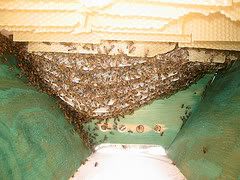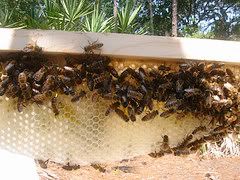Total Expansion!
Russian Hive:
Not much has changed. They've begun drawing out some of the frames I put in the brood box but, haven't touched the super of foundation above. They seemed a little "nervous" on the comb today in that they practically refused to stay in one spot. The palmetto on site is in full bloom but, do to a lack of rain, necar production is minimal at best. If we could just get a few good rainy days then maybe this flow could produce something. On a more possitive note, the queen is laying more eggs and I'm noticing an improving brood pattern. Oddly enough, they're not storing anywhere near as much pollen as the Italian Hive, an of cource, MUCH more propolis. I may concider making a propolis trap as, when it is mixed with beeswax and some sort of oil, it makes a wonderfull instrument varnish.
KTBH:

The bees are on bars 1-8 with drawn comb. Some of this comb is already about 6 inches deep and at full thickness. I've also seen plenty of eggs, pollen, larvae and now, capped brood. They're also drawing it perfectly center on the bar, making for management almost as easy as with a conventional frame hive.

Here's a picture of the sixth comb (1=front 32=back). You can see the very palmettos I was talking about earlier. If you look carefully, you can see BEES, pollen, necar ripening and capped brood.
Not much has changed. They've begun drawing out some of the frames I put in the brood box but, haven't touched the super of foundation above. They seemed a little "nervous" on the comb today in that they practically refused to stay in one spot. The palmetto on site is in full bloom but, do to a lack of rain, necar production is minimal at best. If we could just get a few good rainy days then maybe this flow could produce something. On a more possitive note, the queen is laying more eggs and I'm noticing an improving brood pattern. Oddly enough, they're not storing anywhere near as much pollen as the Italian Hive, an of cource, MUCH more propolis. I may concider making a propolis trap as, when it is mixed with beeswax and some sort of oil, it makes a wonderfull instrument varnish.
KTBH:

The bees are on bars 1-8 with drawn comb. Some of this comb is already about 6 inches deep and at full thickness. I've also seen plenty of eggs, pollen, larvae and now, capped brood. They're also drawing it perfectly center on the bar, making for management almost as easy as with a conventional frame hive.

Here's a picture of the sixth comb (1=front 32=back). You can see the very palmettos I was talking about earlier. If you look carefully, you can see BEES, pollen, necar ripening and capped brood.
0 Comments:
Post a Comment
<< Home